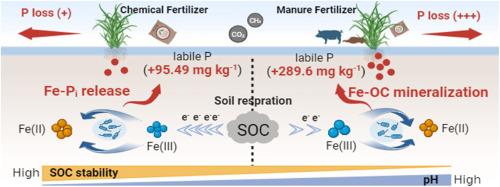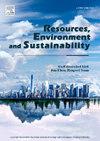Iron-organic carbon coupling controls phosphorus transformation and release in decades manure-enriched paddy soil
IF 7.8
Q1 ENVIRONMENTAL SCIENCES
引用次数: 0
Abstract
Manure fertilizer, as high P source, is widely used to enhance soil P availability, achieving organic waste recycling and sustainable agriculture. However, the excessive application of manure fertilizer poses risks of P loss. Herein, we address this critical challenge through a 25-year in-situ field experiment combined with a 60-days anaerobic incubation experiments, exploring the vital roles of iron (Fe) and organic carbon (OC) in regulating P transformation. Our in-situ field results reveal that prolonged manure fertilizer inputs resulted in the decoupling of the Fe dissolution and inorganic P (Pi) release in paddy soil. Under the further anoxic incubations, the results showed both chemical fertilizer (CF) and manure fertilizer (pig manure, CPM) lifted the Pi concentration due to dissimilatory Fe reduction, but through different mechanisms. In CF treatment, the increased P mainly derived from the release of Fe-bound Pi (Fe-Pi). CPM enhanced the Fe transformation from crystalline to amorphous, resulting in 18.8 % loss of Fe-bound OC, this resulted in the coupled Fe-bound organic P (Fe-Po) decreased from 455.4 to 7.9 mg kg−1, ultimately leading to a sharp increase in labile P from 177.2 to 353.4 mg kg−1. Notably, Fe-bound lipids and proteins were more prone to microbial degradation, accelerating the breakdown of organic matter and enhancing P mobilization. Our findings underscore the pivotal role of Fe-OC interactions in controlling P release and provide critical insights for developing more effective strategies to optimize P management in sustainable agricultural practices.

铁-有机碳耦合控制着几十年富肥水稻土磷的转化和释放
粪肥作为高磷源,被广泛用于提高土壤磷素有效性,实现有机废物循环利用和农业可持续发展。然而,过量施用有机肥会造成磷流失的风险。在此,我们通过25年的现场实验结合60天的厌氧培养实验来解决这一关键挑战,探索铁(Fe)和有机碳(OC)在调节P转化中的重要作用。结果表明,长期施用有机肥导致水稻土中铁的溶解与无机磷的释放解耦。结果表明,在进一步的缺氧培养条件下,化肥(CF)和粪肥(猪粪,CPM)均通过异化铁还原作用提高了磷浓度,但作用机制不同。在CF处理下,磷的增加主要来源于Fe-Pi (Fe-Pi)的释放。CPM促进了Fe从晶态到非晶态的转变,导致铁结合OC损失18.8%,这导致耦合铁结合有机P (Fe- po)从455.4下降到7.9 mg kg - 1,最终导致不稳定P从177.2急剧增加到353.4 mg kg - 1。值得注意的是,铁结合的脂质和蛋白质更容易被微生物降解,加速了有机物的分解,增强了磷的动员。我们的研究结果强调了Fe-OC相互作用在控制磷释放中的关键作用,并为制定更有效的策略来优化可持续农业实践中的磷管理提供了重要见解。
本文章由计算机程序翻译,如有差异,请以英文原文为准。
求助全文
约1分钟内获得全文
求助全文
来源期刊

Resources Environment and Sustainability
Environmental Science-Environmental Science (miscellaneous)
CiteScore
15.10
自引率
0.00%
发文量
41
审稿时长
33 days
 求助内容:
求助内容: 应助结果提醒方式:
应助结果提醒方式:


